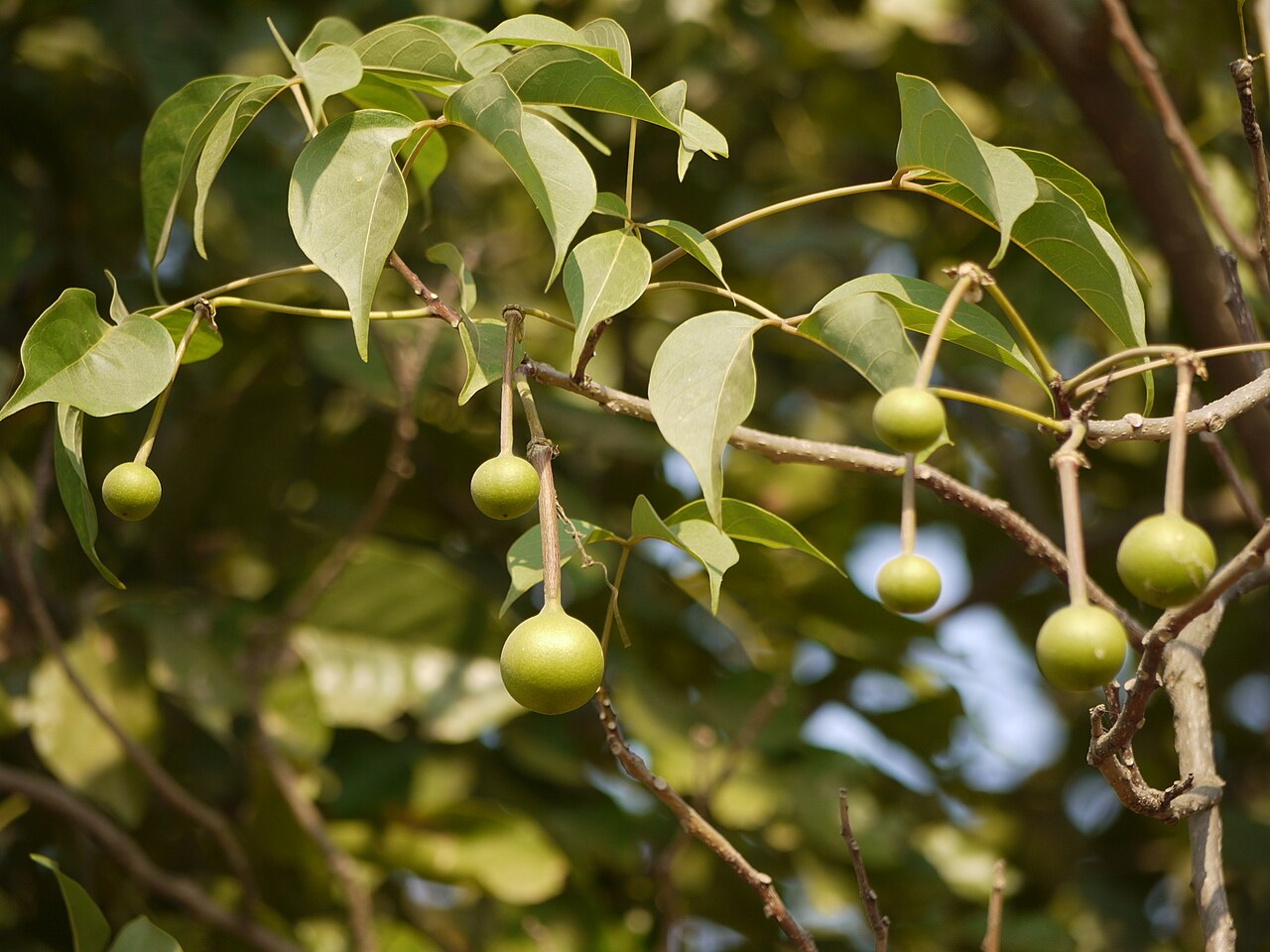Crateva adansonii

|
|
Crateva adansonii Common Names: Sacred garlic pear, Varun, Three-leaf
caper, Barna Scientific
Classification Kingdom: Plantae Clade: Tracheophytes Clade: Angiosperms Clade: Eudicots Clade: Rosids Order: Brassicales Family: Capparaceae Genus: Crateva Species: C. adansonii Synonyms: Crateva guineensis Schumach. & Thonn., Crateva laeta DC., Crateva religiosa var. brevistipitata De Wild. Morphological Description Crateva adansonii is a deciduous tree, typically growing 5–25 meters tall,
with a spreading canopy. Its key characteristics include: · Bark: Rough, greyish-brown, often fissured, used medicinally for
its bioactive compounds. · Leaves: Trifoliate, with elliptical to ovate leaflets (5–12 cm × 2–5
cm), glossy, dark green, with entire margins; petioles 3–8 cm long (Burkill,
1985). · Flowers: Fragrant, white to pale yellow, 3–5 cm in diameter, arranged
in terminal corymbs; petals are clawed, and long, spidery stamens give a
crown-like appearance. · Fruit: Globose to pear-shaped capsules (3–5 cm), green turning
brown, containing numerous seeds embedded in a pulpy matrix; edible but rarely
consumed. Distribution and Habitat Crateva adansonii is widely distributed in tropical regions, particularly in
Africa, with some presence in Asia: · Geographic Range: Native to West and Central Africa
(Senegal, Nigeria, Cameroon, Gabon, DR Congo); extends to East Africa (Uganda,
Tanzania) and parts of Asia (India, Sri Lanka); cultivated in Nigeria for medicinal
and ornamental purposes. · Habitat: Thrives in lowland forests, riverbanks, savanna woodlands,
and coastal areas; prefers moist, well-drained soils (pH 5.5–7.0) with annual
rainfall of 800–2,000 mm; tolerates elevations up to 1,200 m. · Ecological Role: Stabilizes riverbanks and supports
pollinators like bees and butterflies; its fruits are dispersed by birds and
mammals, contributing to forest regeneration. Ethnopharmacology Crateva adansonii, commonly known as the sacred garlic pear or three-leaf caper, is
a medicinal plant traditionally used in various parts of Africa and Asia. Its
bark, leaves, roots, and fruits are rich in bioactive compounds and are widely
employed for their anti-inflammatory, analgesic, antioxidant, antimicrobial,
antidiabetic, hepatoprotective, and diuretic properties. In traditional
medicine, the bark is often used to treat rheumatism, urinary tract infections,
and fevers, while the leaves are used in managing wounds, abscesses, and
digestive disorders. The plant is also known to support kidney and liver
function, and its extracts have shown potential in alleviating arthritis and
jaundice. Phytochemical studies have identified the presence of flavonoids,
saponins, alkaloids, tannins, and triterpenoids, which contribute to its
pharmacological actions. Despite its broad traditional use, more clinical
research is necessary to fully substantiate its efficacy and safety for modern
therapeutic applications. · Anti-inflammatory: In
Nigeria, bark extracts treat rheumatism. Methanol leaf extracts (400 mg/kg)
reduced carrageenan-induced paw edema by 61% in rats, linked to lupeol and
flavonoids (Rathinavel et al., 2021). · Analgesic: In
Cameroon, leaf sap relieves pain. Methanolic stem-bark extracts (400 mg/kg)
increased pain reaction time by 94.76% in rats, surpassing pentazocine (3
mg/kg) in hot plate assays (Akanji et al., 2013). · Diuretic and Anti-urolithiatic: In Benin, bark decoctions treat urinary issues.
Petroleum ether bark extracts (200 mg/kg) reduced calcium oxalate crystals by
50% in rat kidneys, promoting urine output by 35% (Gupta et al., 2006). · Antimicrobial: In
Togo, leaves treat abscesses. Ethanol leaf extracts exhibited MIC values of
125–250 μg/mL against Staphylococcus
aureus and Pseudomonas aeruginosa, validating wound-healing applications (Ahama-Esseh et al.,
2017). · Anticancer: In
Cameroon, bark is used for tumors. Dichloromethane/methanol bark extracts (75
mg/kg) reduced mammary tumor burden by 88.64% in DMBA-induced rats, with
daucosterol as a key active compound (Zingue et al., 2016). Daucosterol, a
compound isolated from C. adansonii, demonstrated significant in vivo
anticancer effects by reducing 7,12-dimethylbenz(a)anthracene
(DMBA)-induced breast tumor volume by 48.5% and tumor weight by 40% in Wistar
rats treated with 10 mg/kg for 20 weeks. The compound also modulated estrogen
receptor expression, indicating its potential in breast cancer therapy (Nguedia
et al., 2020). · Analgesic
and Antioxidant Activity:
The hydromethanolic extract of Crateva adansonii stem bark exhibited
significant analgesic activity, reducing acetic acid-induced writhing in mice
by 54.3% at 400 mg/kg and increasing pain latency in the hot plate test by
68.2% compared to controls. Additionally, it demonstrated notable antioxidant
properties, scavenging 72.4% of DPPH radicals at 100 µg/mL, supporting its
traditional use in pain management and oxidative stress-related conditions
(Udeh & Onoja, 2015). · Antiplasmodial
Activity: The aqueous leaf extract
of C. adansonii showed a 61.35% inhibition of Plasmodium berghei parasitemia in
infected mice at a dose of 400 mg/kg, with a dose-dependent reduction in
parasite density observed over 4 days. The extract's LD50 was determined to be
3,500 mg/kg in acute toxicity studies, indicating a relatively high safety
margin for oral administration (Tsado et al., 2020). · Antihyperglycemic
and Antioxidant Effects:
The hydroethanolic extract of C. adansonii leaves significantly reduced blood
glucose levels by 45.6% in glucose-loaded hyperglycemic mice at 400 mg/kg
within 2 hours. It also exhibited antioxidant activity, inhibiting lipid
peroxidation by 60.2% and increasing catalase activity by 35% in liver
homogenates, suggesting its potential in managing diabetes mellitus and
associated oxidative stress (Kokou et al., 2020). ⚠ Toxicity Profile: Crateva adansonii is generally safe at therapeutic doses,
but high doses may cause toxicity. Aqueous leaf extracts (up to 5,000 mg/kg)
showed no acute toxicity (LD₅₀ > 5,000 mg/kg) in rats, but subchronic use
increased serum ALP and γ-GT levels, indicating potential liver and kidney
stress (Akanji, 2013). Additional Uses · Culinary: Young leaves are occasionally cooked as a vegetable in
Nigeria, added to soups for their mucilaginous texture. · Ornamental: Planted for its attractive flowers and shade in gardens and
along riverbanks in Cameroon and India. · Environmental: Used in agroforestry to stabilize riverbanks and enhance
soil fertility; its fruits support local wildlife. References
External Links More Pictures |
|
| Compounds of Crateva adansonii |
|
| References |